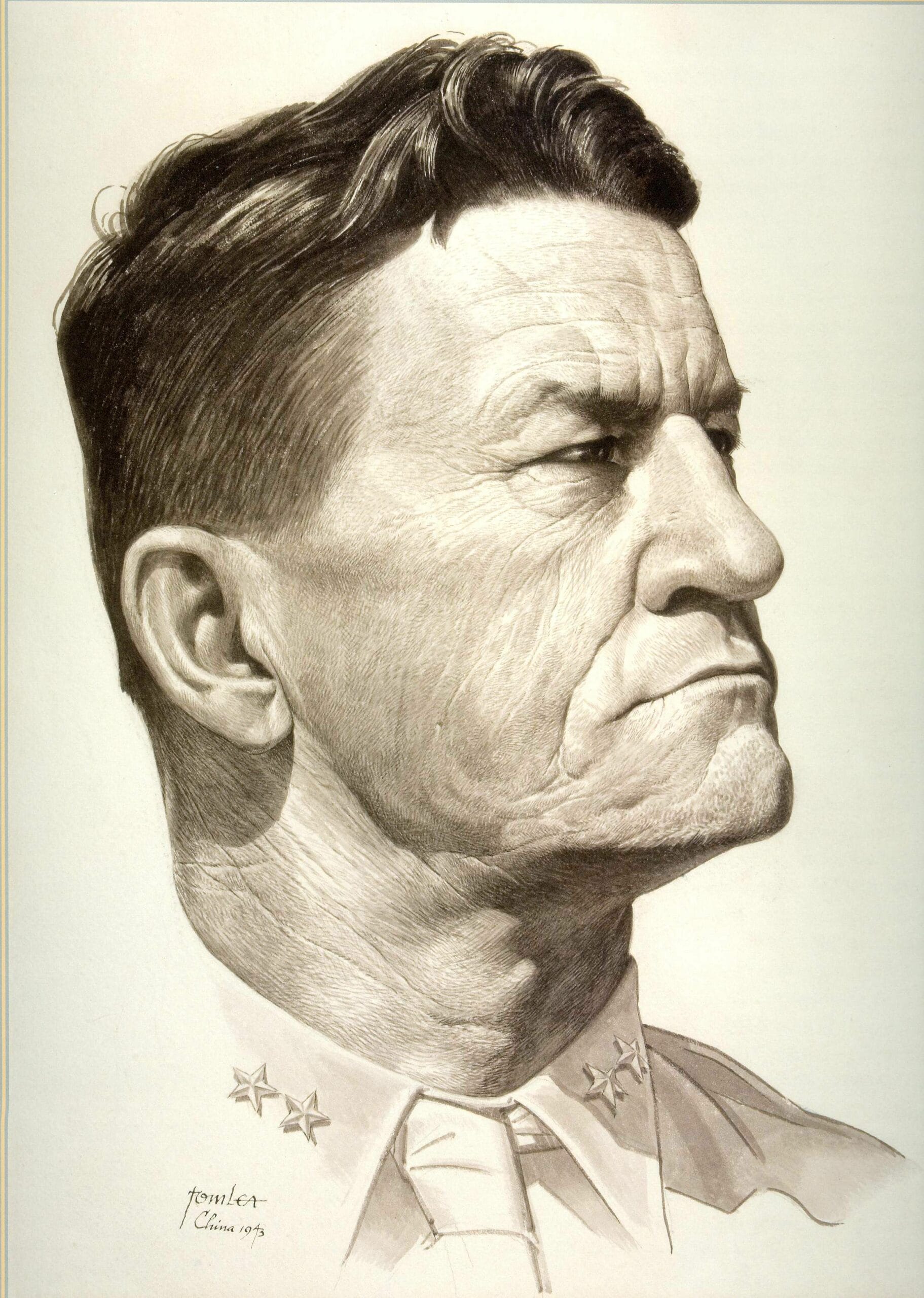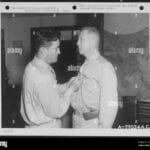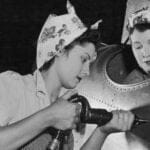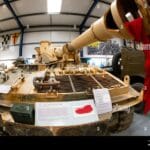A Pilot Ahead of His Time
Claire L. Chennault, a name synonymous with aviation daring, wasn’t your typical military man. Born in 1893, this rebellious spirit traded a traditional teaching career for the allure of flight in the early 20th century. As World War I erupted, Chennault soared through the skies, proving his exceptional skill as a pilot. During a time when the concept of airpower was in its infancy, Chennault emerged as a visionary, recognizing the transformative potential of aircraft in warfare. Despite facing resistance and skepticism, he passionately advocated for the future of air combat, laying the groundwork for his remarkable legacy.
Forging a Legend: The Flying Tigers Take Flight
Fast forward to 1937, a turbulent time when China found itself locked in a desperate struggle against Japanese aggression. Recognizing the dire need for air superiority, China sought the expertise of Claire Chennault. Tasked with assessing and bolstering their fledgling air force, Chennault recognized both the potential and the challenges they faced. It was here that the legend of the Flying Tigers would be born.
Chennault’s vision extended beyond simply assembling a squadron; he sought to create a fighting force defined by innovation and audacity. The American Volunteer Group (AVG), better known as the Flying Tigers, became his brainchild. This intrepid group of American pilots, eager to join the fight, embraced Chennault’s unconventional tactics and unwavering belief in the power of airpower.
Deciphering Chennault’s AVG: A Deeper Look
Chennault’s understanding of airpower extended far beyond aerial combat. He recognized that true dominance in the skies stemmed from a fusion of skilled pilots, superior intelligence gathering, and constant technological advancement. In essence, Chennault was crafting the blueprint for modern air warfare.
The Flying Tigers, under Chennault’s guidance, became a testament to his unorthodox yet highly effective strategies. They flew with a mixture of American audacity and calculated risk-taking, pushing their P-40 Warhawks to the limits. Their successes against the formidable Japanese Zero fighters in the China Burma India Theater showcased not only their individual prowess but the power of Chennault’s revolutionary tactics.
Key Insights into Chennault’s AVG:
- Chennault’s vision: The AVG was more than a collection of daring pilots; it represented a radical shift in air combat strategy, prioritizing speed, agility, and coordinated attacks.
- Impact beyond “shark teeth”: While the P-40’s iconic design became synonymous with the Flying Tigers, their true significance lay in their strategic impact, altering the course of the air war in China.
- From Flying Tigers to modern air combat: Chennault’s emphasis on pilot skill, intelligence gathering, and technological superiority would shape the future of air warfare, with his influence felt long after WWII.
Navigating Controversy and Cementing a Legacy
Chennault’s path was rarely smooth. His outspoken nature and unwavering belief in his methods often put him at odds with superiors. His close relationship with Chiang Kai-shek, the leader of China, and his strategic clashes with General Joseph Stilwell, a key figure in the China Burma India Theater, are now the stuff of military legend.
Yet, despite the controversies, Chennault’s impact remains undeniable. He left an indelible mark on modern airpower theory, his fingerprints visible on the strategies employed in air conflicts to this day. Furthermore, his influence on the delicate balance of US-China relations continues to resonate in the 21st century.
Remembering the Human Element
Chennault’s story wasn’t confined to the cold calculations of military strategy. He was a leader who witnessed firsthand the brutal realities of war and the sacrifices made by those under his command. Leading the Flying Tigers meant navigating the complexities of managing a diverse group of strong-willed volunteers, each with their own motivations and backgrounds. Additionally, he faced the daunting logistical challenges of keeping his aircraft operational in the heart of a warzone.
The Flying Tigers: A Legacy Remembered
Does China Remember the Flying Tigers?
The resounding answer is yes. The bravery of the Flying Tigers, those American pilots who stood shoulder-to-shoulder with China against Japanese aggression, has not faded from memory.
Enduring Remembrances Across China:
* Museums and memorials dedicated to the Flying Tigers stand as testaments to their valor.
* Yearly events and commemorations keep their memory alive.
* The iconic image of the P-40 Warhawk, with its menacing shark teeth, remains a powerful symbol of their legacy.
Personal Accounts:
Long Qiming, a former ground crew member, vividly recalls the Flying Tigers’ arrival, stating, “It was like the sun breaking through the clouds. They gave us hope that we could actually stand up to the Japanese.”
Evolving Narratives:
While universally recognized as heroes, the interpretation of the Flying Tigers’ impact can differ. Some Chinese historians suggest their role has been amplified over time; however, there’s no denying the powerful message their presence conveyed – one of international unity against oppression.
A Legacy Transcending Time:
The Flying Tigers’ story continues to resonate within China, fostering national pride and serving as a poignant reminder of the potential for collaboration between China and the U.S., as evidenced by the recent purchase of a P-40 Warhawk by the Chinese government from the U.S. The Flying Tigers’ story is not merely a historical footnote but a vibrant part of the ongoing narrative of these two world powers.
Who Led the Flying Tigers?
The Flying Tigers, those daring American pilots who took to the skies for the Chinese Air Force against Japan, were shaped by the leadership of Claire Lee Chennault. Born in Texas in 1893, Chennault’s life seemed destined for aviation.
A Military Trailblazer:
- Chennault’s career began in the U.S. Army Air Service during World War I, where he excelled as a flight instructor.
- Even in those early days, his forward-thinking approach to air combat, while sometimes controversial, hinted at the innovative tactics he would become known for.
Recognizing the Threat, Answering the Call:
- By the 1930s, Chennault found himself advising Chiang Kai-shek in China, witnessing Japan’s growing military ambitions. He understood that a robust air force was essential if China was to resist.
- When World War II erupted, Chennault successfully lobbied the U.S. government to back a group of volunteer pilots – the foundation of the legendary Flying Tigers.
Shaping an Elite Force:
- Chennault’s Flying Tigers were not just pilots; they were a select group drawn from the U.S. Army Air Corps, Navy, and Marines, each with a thirst for action.
- He instilled in them his own brand of audacious tactics, emphasizing all-out aggression, seamless teamwork, and exploiting enemy weaknesses.
Against All Odds:
- Despite being outnumbered, outgunned, and facing a technologically superior enemy, the Flying Tigers, under Chennault’s leadership, became a force to be reckoned with.
- Their staggering record – nearly 300 enemy planes shot down – sent shockwaves through the war’s landscape.
Beyond Tactics, A Leader of Men:
- Chennault was more than a brilliant strategist; he was a leader who fostered an unbreakable sense of brotherhood among his men.
- He demanded discipline but inspired profound loyalty, a testament to his ability to connect with the individuals under his command.
A Legacy in the Skies:
- Even after the echoes of WWII faded, Chennault’s impact on air combat continued to reverberate.
- Today, he is considered one of the key architects of modern air combat strategy, his ideas still studied and debated in military circles around the world.
Important Points to Remember about Claire L. Chennault:
- A Rebel with a Vision: From a young age, Chennault displayed a rebellious spirit and an unwavering passion for the potential of aviation.
- The Birth of a Legend: He founded the Flying Tigers, forever etching his name in the annals of aviation history.
- Master Tactician: Chennault developed groundbreaking tactics and strategies that revolutionized air combat, shaping how air wars are fought to this day.
- Airpower Pioneer: He was among the first to recognize and champion the combined power of skilled pilots, intelligence gathering, and technological advancement in aerial warfare.
- A Legacy Forged in Controversy: Despite facing opposition and controversy throughout his career, Chennault’s contributions to modern airpower theory are undeniable.
- Lasting Impact: His insights on intelligence gathering and achieving air superiority continue to resonate in modern military thinking.
- A Complex and Inspirational Figure: Chennault was a complex and passionate individual who inspired fierce loyalty in his men while forever altering the landscape of air combat.
- Enduring Significance: His legacy continues to influence US-China relations and serves as a source of inspiration and study in military circles worldwide.
- Georgia Platform: A Southern Strategy, 1850s - March 31, 2025
- How many weeks is 40 days: Quick Conversion Guide for Accurate Results - March 31, 2025
- How many feet is 300 meters? 984 Feet: Understand Length Conversions Easily - March 31, 2025
















